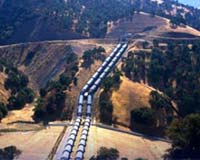
UKRGASENERGO: A NEW RUSSIAN-UKRAINIAN VENTURE TO DOMINATE UKRAINE’S GAS MARKET
Publication: Eurasia Daily Monitor Volume: 3 Issue: 33
By:

A not-so-silent majority in Ukraine’s Cabinet of Ministers, forces ranging from core Orange constituencies to the Party of Regions and groups as diverse as the liberal press and industrial interests, are waging rear-guard actions against the agreement signed on February 2 by Prime Minister Yuriy Yekhanurov with Gazprom’s offshoot RosUkrEnergo. The agreement would create the company UkrGazEnergo — a 50-50 joint venture between Naftohaz Ukrainy and RosUkrEnergo — to market gas within Ukraine. RosUkrEnergo would deliver the mix of Russian and Turkmen gas to Ukraine’s border, then would grab a large share of Ukraine’s internal distribution market from Naftohaz Ukrainy through this joint venture.
Though classified as secret, the package of six documents has become public knowledge thanks to critics within the government and the press. UkrGazEnergo would be jointly headed by Gazprom vice-chairman Alexander Ryazanov, who is also a member of RosUkrEnergo’s board; and Naftohaz Ukrainy vice-chairman Ihor Voronin, who is widely believed to have close links with RosUkrEnergo, and was listed as a member of the latter’s board in 2004.
UkrGazEnergo is slated to become the exclusive supplier to Ukraine’s industry, with the lion’s share of the gas earmarked for the steel and chemical sectors. Through this joint venture, RosUkrEnergo takes away half of Naftohaz Ukrainy’s business in these most lucrative sectors of Ukraine’s gas market. Naftohaz remains the supplier of “communal gas” to households and municipal utilities — a market where Naftohaz can at best break even financially, due to the low solvency of many customers. That problem will only worsen as the cost of gas reaching Ukraine from Russia rises to $95 per 1,000 cubic meters in the first half of 2006, compared to $50 through 2005.
Thus, revenue losses in both the industrial and the communal sector can threaten Naftohaz Ukrainy’s financial basis and prevent it from maintaining Ukraine’s gas transport network in good technical condition. To perform such maintenance (not to mention modernization) or even to survive, Naftohaz may have to go into debt. Meanwhile, the joint venture UkrGazEnergo will be well placed to establish control over those sections of the distribution pipelines that supply the industrial consumers, hitherto Naftohaz Ukrainy’s domain. All this leads to apprehensions that the joint Russian-Ukrainian company has been conceived not only for its stated purpose, but also as a half-way house for gradually transferring control over transport pipelines from Ukrainian to Russian interests.
The $95 price for mix of Russian and Turkmen gas delivered by RosUkrEnergo is not guaranteed beyond July 1 of this year, and is anyone’s guess in the contract period through 2010. It is highly likely to rise in those years, due to international market trends and, particularly, Turkmenistan’s stated intention to increase the sale price of its now under-priced gas.
Ryazanov and the RosUkrEnergo directors Konstantin Chuychenko and Oleg Palchikov have explicitly stated in the Kyiv media that the price of gas to Ukraine beyond July 1 will change depending on the price of Russian and Central Asian gas sold to RosUkrEnergo; that is, upward (Interfax-Ukraine, February 2, 3). Procedures for changing the price are vaguely defined in the documents and, thus, are ultimately at the supplier’s discretion.
The agreement is said to fix Ukraine’s transit charge on Gazprom’s and RosUkrEnergo’s gas en route to Europe at only $1.60 (compared to an European average of ca. $2.50) per 1,000 cubic meters per 100 kilometers for the period 2006-2030. Meanwhile, in 2006-2010, Gazprom would withhold $250 million annually from its payments for Ukraine’s transit services, so as to recoup Ukraine’s $1.25 billion debt for past deliveries of Russian gas. Thus, de facto, the transit rate remains at the old level of $1.09 per 1,000 cubic meters per 100 kilometers during 2006-2010. The new transit rate of $1.60 will, in practice, take effect after the debt repayment.
In 2006-2030, Ukraine is to store annually 15 billion cubic meters of gas belonging to RosUkrEnergo. The charge for this service is said to be fixed at only $2.26 per 1,000 cubic meters of gas per year, an extremely low rate compared to those charged in most European countries.
According to RosUkrEnergo board member and Raiffeisen Invest Bank representative Wolfgang Putschek, RosUkrEnergo’s “business leadership is with Gazprom. Formally it is 50-50, but in practice Gazprom is the leading partner.” Putschek, who represents the mysterious “Ukr” side in RosUkrEnergo, admits, “We have an image problem,” quite apart from the fact that the nominally Ukrainian shareholders “exercise no control over operational questions” (New York Times, February 1).
In sum, through the two-tiered RosUkrEnergo-UkrGazEnergo system, Gazprom seems poised to make massive inroads into Ukraine’s gas distribution and transport system — the main gas route to Europe — as well as into the country’s key industries if it can force them into debt and then debt-for-assets swaps.
(Interfax-Ukraine, Channel Five TV [Kyiv], February 8-14; Zerkalo nedeli, February 10)




